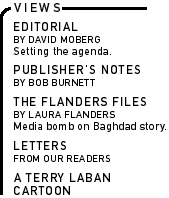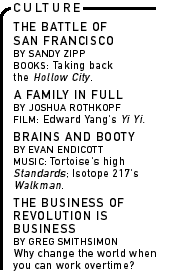

|

|

|

|
| |
|
|
|
Secretary of Defense Donald Rumsfeld will soon receive a far-reaching report likely to serve as the working blueprint for the Pentagon's future. Given that the author of that report is a futurist fascinated with the most advanced technologies, the document is expected to be chock full of recommendations emphasizing an expansive embrace of "information age" weaponry and a shift away from more conventional procurements. Indeed, reading the February 9 Washington Post, one might be inclined to think that Andrew Marshall, head of the Pentagon's Office of Net Assessment (ONA), is an exceptional island of ingenuity and integrity floating amidst the vast archipelago of corrupt and conniving Defense Department bureaucrats. According to Post reporter Thomas Ricks, Marshall is "one of the Pentagon's most unconventional thinkers," a man who is "controversial" due to his prescient, visionary views that are "hardly conservative." Because Marshall has scrapped with the military brass over a handful of doctrinal and procurement issues, he's a "radical reformer." Not that the average person would know any of this, of course, as Marshall is "all but unknown outside national security circles" and is legendary for being "publicity-shy." For a guy who has been ensconced at the Pentagon since 1973--and began work as an
But it's his subtle role as a National Missile Defense booster that has many concerned about his leading the Pentagon's latest top-to-bottom review. "Putting Andy Marshall in charge of this is a ploy to make sure National Missile Defense gets funded," says Mel Goodman, a veteran CIA analyst now at the National Defense University. "If he can justify making cuts in conventional procurement, they can then justify taking $60 billion to throw at NMD. This is the first secretary of defense to turn over a key problem to his net assessment adviser, which is a strange way to do business. If they were serious about this, they would not be looking for answers in several weeks." According to those who have worked with Marshall, or kept an eye on him, his vision of defense revolves around the notion that in the future wars will not be fought up close with aircraft carrier sorties and armor and infantry deployments, but from a distance with long-range arsenal ships and planes, networked sensor arrays and precision weapons. As such, Marshall has been particularly critical of the Air Force's F-22 fighter program--the plane, he says, has too short a range to be useful to the American military of the future. Marshall's opposition to the F-22 is often touted as an example of his "iconoclastic" thinking. But according to investigative journalist Ken Silverstein--who profiled Marshall in his book Private Warriors--opposition to the F-22 doesn't make Marshall a maverick visionary. "So he has been a critic of the F-22, fine and dandy," Silverstein says. "But you can find case after case where he has come out in support of other systems that are just as worthy of skewering. Saying he's a tough critic is like saying Jack Valenti is a tough critic of the movie industry." Silverstein is perhaps the only author who has written critically of Marshall. While Marshall gave rare interviews to Ricks for a fawning 1994 Wall Street Journal piece and to right-wing historian Jay Winik for an admiring April 1999 article in Washingtonian magazine, Marshall declined to answer any of Silverstein's queries. Noting that only a handful of sycophantic articles were responsible for Marshall's public image, Silverstein expressed great skepticism in his book about some of Marshall's claims, including one that the ONA had been the first to sound the national security alarm about AIDS in the '80s, going so far as to alert the Centers for Disease Control to take the problem seriously. (CDC did not respond to queries from In These Times about any contact between ONA and CDC, but according to interviews with Pentagon sources who remember early '80s briefings on AIDS, no one can recall any involvement--or advocacy role--from Marshall's office.) Another claim Silverstein found a bit difficult to swallow was a riff from Ricks' Journal piece, in which he asserted: "Well ahead of most Sovietologists, Mr. Marshall noticed the weakness of Soviet society." In fact, Silverstein wrote, Marshall's "associates have no recollection of Marshall ever having expressed such views." He quoted a former staffer as saying, "Until the very end he was a major promoter of the line that 'The Russians are coming and they're ten feet tall.' " Indeed, Marshall had long hyped the Soviet threat. In 1977, he was one of the quietly forceful hands behind the infamous "Team B" episode, in which members of the far-right Committee on the Present Danger were given access to CIA data and allowed to histrionically rewrite the National Intelligence Estimate on Soviet Military Intentions. Though Winik wrote in Washingtonian that Marshall later rebuked the intelligence community for overestimating Soviet strengths in the '80s, Lawrence Korb, a former Pentagon official now at the Council on Foreign Relations, recalls that Marshall actually considered the Soviets a greater danger than ever before as the '80s and early '90s unfolded (see "Ten Myths About the Defense Budget," page 10). "Andy's idea was that as they were collapsing, they'd lash out and were more dangerous," Korb says. "That was one that was wide off the mark." In the early '80s, it was Marshall's view that to ensure the Soviet Union's speediest demise, it was imperative to arm the Afghan muhjahadeen with Stinger missiles, a move opposed by even the CIA--which rightfully feared that the weapon would inevitably end up on the black market and in Soviet hands. But two close Marshall associates at the Pentagon, Fred Ikle and Michael Pillsbury, pushed hard to see that Marshall's argument won the day. Later they would argue that this proposal won the war in Afghanistan. But as former Times of London defense correspondent James Adams wrote in his 1990 book Engines of War: "In the self-congratulation that followed the Soviet withdrawal, three key legacies of the war were generally overlooked: the impact on Soviet society and its armed forces, the arms market created by the war and the heroin and marijuana market that has grown in Pakistan and Afghanistan as a result of the war." According to several former intelligence analysts, Marshall's supposedly long-range, forward-thinking shop was simply oblivious to this reality, blinded by what Adams characterized as the "holy crusade" against the Soviets that the Afghanistan cause had become. Even though the Stinger shipments did result in more destroyed Russian helicopters, they were not decisive in forcing the Soviet withdrawal. In fact, they may have made the war more brutal. "The Soviet policy of scorched earth and the depopulation of rural areas destroyed much of the country's traditional economic infrastructure," Adams wrote. "The people who remained in the country were forced to turn to agriculture that did not depend on complex irrigation systems." As a result, poppy cultivation and the export of heroin shot through the roof. To a number of former intelligence analysts, Marshall's role in getting Stinger missiles sent to the Afghan muhjahadeen highlights a certain myopia of the ONA-style of thinking. "I don't recall where he was out in front of the whole Soviet issue--if anything, he may have said it was time to throw more money into taking out the Soviets at a time when we were spending too much already," says Goodman, formerly one of the CIA's top Sovietologists. This type of thinking is what has critics most worried about NMD. Though Silverstein holds that Marshall "has been an enthusiastic supporter of Star Wars schemes," current and former colleagues contend that Marshall--who, despite being enamored of futuristic weapons concepts, writes in longhand, does not use a computer and doesn't have call waiting, according to Winik--is much more subtle and circumspect in his support of NMD. Few of his associates, from the past or present, in fact, are willing to ascribe any particular view to him, and not just because of his legendary taciturn bent. ("He's as Delphic as they come--days may go by before he utters a word," says a former ONA staffer, adding that this proclivity for reticence has earned him the nickname "Yoda.") "He is not very interested in the here and now, but is primarily interested in hypothesizing futures that cut against the grain, and you can argue that we really do need someone like that," says Jonathan Pollack, a professor at the Naval War College in Newport, Rhode Island, and one of the leading analysts of the Chinese military. "His interest is to take events as they are understood and find a way to turn them on their head, to conflate understanding, and look for patterns or possibilities that could be studied. And he often comes up with quirky results." But according to a longtime analyst, the product from Marshall's office often seems to be "thinking outside of the box for the sake of thinking outside the box," fused with a touch of the paranoid. "His views are very much animated by the belief that most of those at the Pentagon are asleep at the switch, too wedded to the status quo and weapons systems he believes will be vulnerable in the future," says the analyst. Whether serious policy judgments and spending decisions should be based on this approach is another question. "The reality is a lot of the things he's postulating aren't provable," the analyst adds. "His escape clause is that what he's talking about is not reality today, but is using the equation of 'based on this variable, let's extrapolate and postulate that x could happen, which could lead to y, which could lead to z--and how do we prepare for that?' " Or, to put it more succinctly, Pollack affectionately calls Marshall "a worrywart." To Silverstein, a better description of Marshall is "one of the most effective pork-seeking missiles ever deployed by the military brass." But unlike the actual brass, which loves to spend money on planes, tanks and ships (some of which are archaic and ripe for cutting) Marshall swoons over high-technology networked sensor systems and "smart" weapons--expensive procurements that are notorious for, well, not working. Still, the expectation of many Washington observers is that Marshall's recommendations will give the latest incarnation of Star Wars a boost. As a key witness before Rumsfeld's Commission to Assess the Ballistic Missile Threat to the United States, Marshall played no small role in convincing the commission--whose findings have been cogently criticized by numerous analysts--that a real threat is imminent. "Though Rumsfeld's commission made no recommendation whatsoever on national missile defense, it dealt with the issue very artfully," Pollack says. "In fact, if that commission had a methodology, it was a very Marshallian methodology--you can posit these circumstances, and if you posit the following it's feasible this next thing could happen." And that means a lot of money-making opportunities for defense
contractors. As Pollack says, "This is going to be a gravy train."
|


